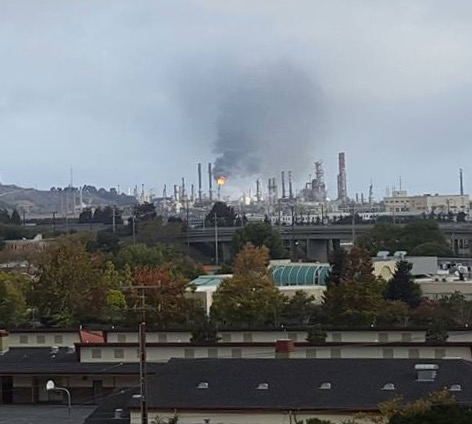Refinery malfunctions led Chevron to send gas to its flares five times in January and then three times every month for the next four months.
Local air regulators say the latest flaring episode took place last week on May 29. The release was caused by the startup of a process unit, according to Chevron spokesman Braden Reddall, who declined to offer more details. The company filed an incident report with the Contra Costa County Hazardous Materials Program that said the unit in question was shut down and that an undetermined amount of sulfur dioxide was released.
Reports filed with the agency about several other flaring episodes reveal more.
The company told the county that a Feb. 2 flaring incident was caused by a "power dip." It led to the release of more than 19,000 pounds of sulfur dioxide over two days.
An "upset" on Feb. 24 led to the release of close to 8,000 pounds of the gas over about 75 minutes.
On March 6 another power issue at Chevron led to the release of around 10,000 pounds of sulfur dioxide over close to six hours, prompting several residents in the area to complain about odors from the refinery.
And on April 13, as the refinery was restarting a unit, it sent gases to its flares, leading to the release of more than 18,000 pounds of sulfur dioxide over three hours and 20 minutes.
"It is a concern that their flaring incidents have increased," said Anthony Wexler, director of the Air Quality Research Center at UC Davis.
Gioia said the power problems associated with some of the flaring incidents have been corrected.
Chevron also suffered two other chemical releases so far this year. The refinery experienced a gas leak on Jan. 17 that led to the release of 100 pounds of hydrogen sulfide, and on March 17 there was a small oil spill from the facility into San Francisco Bay.
Meanwhile, environmentalists are expressing anger over the number of flaring episodes.
"It's unacceptable that these pollution-spewing mishaps are happening more frequently and can emit thousands of pounds of pollution at a time," said Hollin Kretzmann, an Oakland-based lawyer for the Center for Biological Diversity.
"Chevron has a sulfur problem," said Matt Krogh with San Francisco-based Stand.earth. "You're seeing incident after incident after incident happening with no real action taken by the regulators."
Air regulators and industry representatives have emphasized that flares burn refinery gases that would otherwise be directly released into the atmosphere and the practice is designed to protect nearby communities and refinery workers.
“The recent flaring activity is primarily related to startup activities of the new hydrogen processing unit. The refinery will continue to operate safely and expects to continue building on our strong record of reducing flaring activity,” Chevron’s Reddall said in an email.
“The hydrogen plant is part of the refinery’s modernization project,” he added. “Once the project is completed, these improvements will result in an overall decrease in emissions, as well as safety enhancements that far exceed regulatory requirements.”
So far, the air district has not issued any notices of violation against Chevron for its flaring episodes in 2019, according to agency spokeswoman Simrun Dhoot.
Gioia said the agency's focus is on Chevron's hydrogen plant, which creates hydrogen that's used in other parts of the refinery. It began operating last November.
"It's an impressive amount of time. We're seeing seven months of trying to get it right. And they're trying to get it right by releasing toxics into the air," said Stand.earth's Krogh. "That's an unacceptable way to do business."
The number of flaring incidents at Chevron is much higher than at most of the other Bay Area refineries this year.
According to a hazardous materials spill database maintained by the Governor's Office of Emergency Services, the Phillips 66 refinery in Rodeo and the Marathon facility in Martinez each have had two flaring episodes this year. Shell's Martinez refinery had one such incident this year. (You can see the number of flaring incidents each local refinery had between 2005 and 2018 here.)
The other local refinery that's had problems this year is Benicia's Valero facility. In March, a serious malfunction at the Solano County refinery led to two weeks of releases of petroleum coke dust, culminating in a refinery shutdown and brief health advisory. Several government investigations are under way into Valero's breakdown in March and its gradual restarting that took place in May.
This story has been updated to include information from a statement provided by Chevron after publication.
